Chardham Pilgrimage Tour
Get the Best Chardham Darshan Planned by Experts!
Chardham Yatra Tour Packages
Do Dham & Char Dham Yatra Tour Packages (2024) at Best Price
Do Dham yatra means the yatra of Two Dhams out of Four Dhams. There are four Dhams in Uttarakhand, Yamunotri, Gangotri, Kedarnath & Badrinath. All four are sacred places in Uttarakhand for Hindus. Do Dham Yatra is undertaken by the people who have difficulty in trekking. Still, Do Dham yatra is mainly considered the yatra of only two Dhams, Kedarnath and Badrinath. These two Dhams hold so much religious importance for Hindus in India.
Badrinath is a sacred place which is dedicated to Hindus Lord Vishnu Bhagwan. and Kedarnath is a holy temple which is dedicated to the one holy jyotirlinga out of twelve jyotirlingas of Lord Shiva.
Chardham
An overview
Looking for Chardham packages?
Located in the Garhwal region of Uttarakhand, in fact high in the Garhwali Himalayas are some of Hinduism’s most significant sites, also called Chota Chardham - Kedarnath, Badrinath, Gangotri and Yamunotri.
The temples here mark the spiritual sources of the religion’s four sacred rivers - Ganga, Yamuna, Alaknanda and Mandakini, together making up one of the most prominent pilgrimage circuits in the country. The time between April and November each year witnesses the coming of devotees in thousands who brave the harsh weather, the treacherous mountain roads and trails to get to them.
The great philosopher and reformer, Adi Shankaracharya in the 8th century brought together all these pilgrimages into a kind of spiritual circuit, one taken by generations after generations, keeping up the annual tradition of visiting these pilgrimages each year.
Opening and closing dates of Chardham Yatra
When doing a Chardham trip, you would typically be engaged between April and early November. Every year, the government of Uttarakhand announces the dates for the opening and closing of the Chardham circuit.
In the winter months, the deities at each of these shrines are moved to their winter abodes. Ukhimath for Kedarnath, Joshimath for Badrinath, Mukhba for Gangotri and Kharsali for Yamunotri. The doors of these winter abodes remain open through the year and can be visited at your convenience
When finalising one of the Chardham tour packages, make sure it includes a visit to Kedarnath, Badrinath, Gangotri and Yamunotri.
Why DuniyaOnline for Do Dham Travel Packages Booking?
- Vast choices of Do Dham Yatra travel packages
- Recognized by Ministry of Tourism, Government of India
- Budget and luxury Do Dham Packages from Private Travel Companies
- Do Dham Yatra Tours from hotel owners
- Lowest rates and exclusive discounts for Groups and fixed departures
- Close tie-up with Helicopter companies to operate Do Dham Helicopter Tours
Places to visit in Chardham
Kedarnath
Kedarnath lies close to the source of the Mandakini River, the Chorabari Glacier and is backed by the frosty Himalayan peaks. It is at an elevation of 11,755 foot with Gaurikund being the closest road-head to Kedarnath, being about 14 kilometre away. The stone hump worshiped inside the temple has a mythological connection that traces its roots in the epic Mahabharata where the Pandavas after defeating the Kauravas who were after all their own family members, sought mercy of Lord Shiva.
But Shiva refused to forgive them, turning the Pandavas more resolute in their will to seek forgiveness. Shiva in order to evade them turned into a bull and came to earth. In his rush, he left his hump in Kedarnath, close enough to the Chorabari Glacier, a spot marked by an 8th century temple of Adi Shankaracharya.
The other parts of the bull’s body are worshiped at the other four Panch Kedar shrines. The bull’s arms at Tunganath, navel at Madmaheshwar, face at Rudranath and hair at Kalpeshwar. Before booking one of the Chardham holiday packages, make sure it includes a visit to the Kedarnath temple.
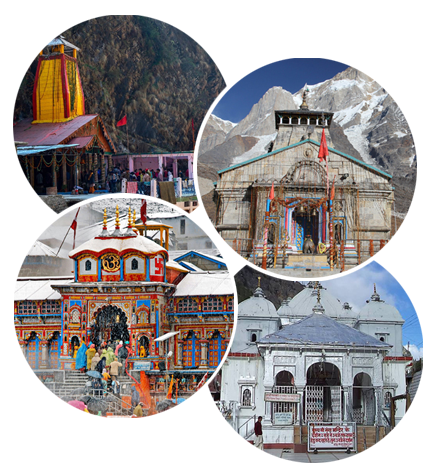
Significance of Kedarnath
The Kedarnath Temple has one of the most dramatic settings of Hindu temples owing to its location close to the Chorabari Glacier from which the Mandakini River originates. Kedarnath is also among the twelve Jyotirlingas, bringing Hindu pilgrims to it all through summer, marked by deep gorges, apple orchards, snow-capped peaks and terraced hill slopes.
You can reach Kedarnath from Gaurikund, the closest road-head which is about 14 kilometre away. The trek goes uphill from Jangal Chatti, about 4 kilometre away, the Chhoti Linchuli and Badi Linchuli before crossing the Mandakini River and heading to the southern face of the Kedarnath peak
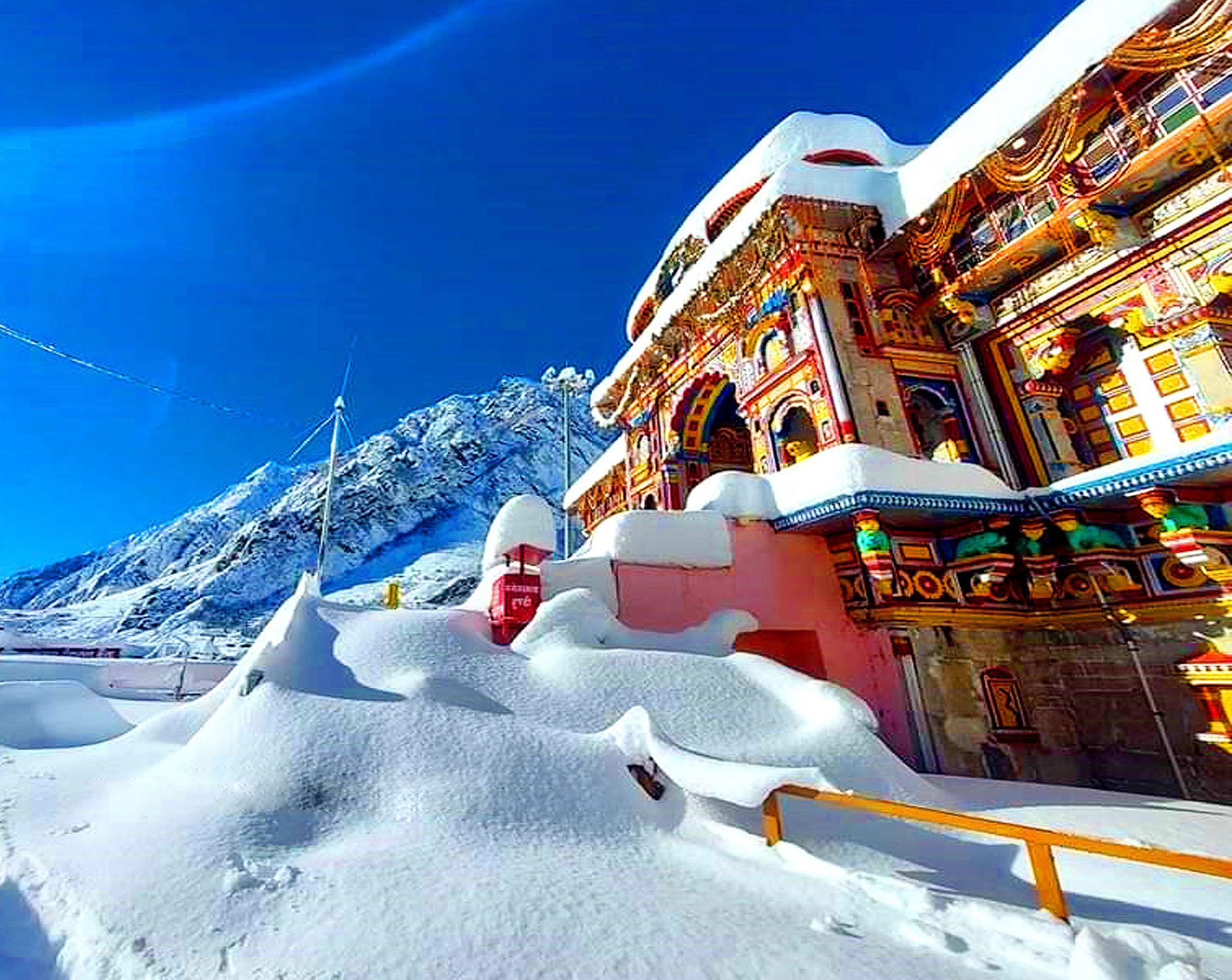
Badrinath
Badrinath Temple too has a stunning setting at the base of the pyramid-shaped, snow-capped Nilkantha peak, dedicated to Lord Vishnu. Picturesquely located, it also happens to be one of Chardham’s most easily accessible temples founded by Guru Adi Shankaracharya in the 8th century.
The temple has been refurbished and renovated over a period of time. At the foot of the temple are hot springs whose waters reach a scathing 40 degree Celsius, serving as a laundry and bath house for the locals. Adi Shankaracharya who built the original Badrinath Temple had found the Badrinayaran idol in the Alakananda River.
The temple as it stands today was built in the 16th century by the King of Garhwal complete with its elaborate carvings, stone embedding, columns, giving the temple the appearance of a Buddhist Vihara. Legend has it that Lord Shiva meditated on this spot for many years while Goddess Lakshmi offered shade to him in the form of a Badri tree, fetching the place its name.
Even today, the surrounding Kedar-Badri valley is believed to be the home of Lord Shiva, a reason people slate their annual Chardham tour around Mahashivaratri when the festivities pump life and colour into the shrines.
Significance of Badrinath
A holy shrine for Vaishnavites, Badrinath is among the 108 Divya Desams incarnation of Vishnu. Aside from that Badrinath is also among the Panch Badri temples namely Yog Dhyan Badri, Adi Badri, Bhavishya Badri, Vriddha Badri and Badrinath temple. At an elevation of 11,204 foot in Uttarakhand’s Chamoli district, Badrinath is nestled in the quiet Garhwal valley, on the shores of the mighty Alaknanda.
The Badrinath town is pristine and beautiful, peppered by thick forests, ample views of frosted mountain peaks and the holy river cutting through the green valley and flowing down it. Some prominent celebrations that take place in Badrinath include Kedar-Badri Utsav, Janmashtami and Mata Mruti ka Mela. Sights you can round up close to Badrinath include Badri Narayan Temple, Panch Prayag Temple, Tapt Kund for their hot water springs, Mana village, Bheem Pul, and Vasudhara Falls among others
Gangotri
The Gangotri Temple is one of the holiest shrines in the country primarily for being a source of the most revered Hindu river, the Ganges. According to mythology, the rock on the site served as a cushion to save the earth from havoc the river could have caused as it poured out of Shiva’s matted locks in heaven.
Lord Shiva is believed to have placed that rock strategically to take the onslaught of the gushing waters. The Gangotri Temple goes back to the 18th century when it was built by Amar Singh Thapa, a Gorkha commander. Though it is Gaumukh which is the foremost source of the Ganges, Gaumukh being a glacier about 19 kilometre further from the Gangotri Temple.
Gangotri at an elevation of 10,170 foot lies on the banks of the Bhagirathi River, Ganga being called Bhagirathi till it reaches Devprayag, where Bhagirathi meets the Alakananda to form the Ganges. The Gangotri Temple opens on Akshay Tritiya, typically in May and shuts down on Bhai Duj, typically in late October or November.
Harking back on Ganga’s healing and spiritual properties, pilgrims carry back bottles full of holy water from here. The Gangotri region has a rich biodiversity, being rich in several endemic species of flora and fauna. There are several smaller temples close to the main shrine, each reiterating Ganga’s evolution while tracing back its mythological roots.
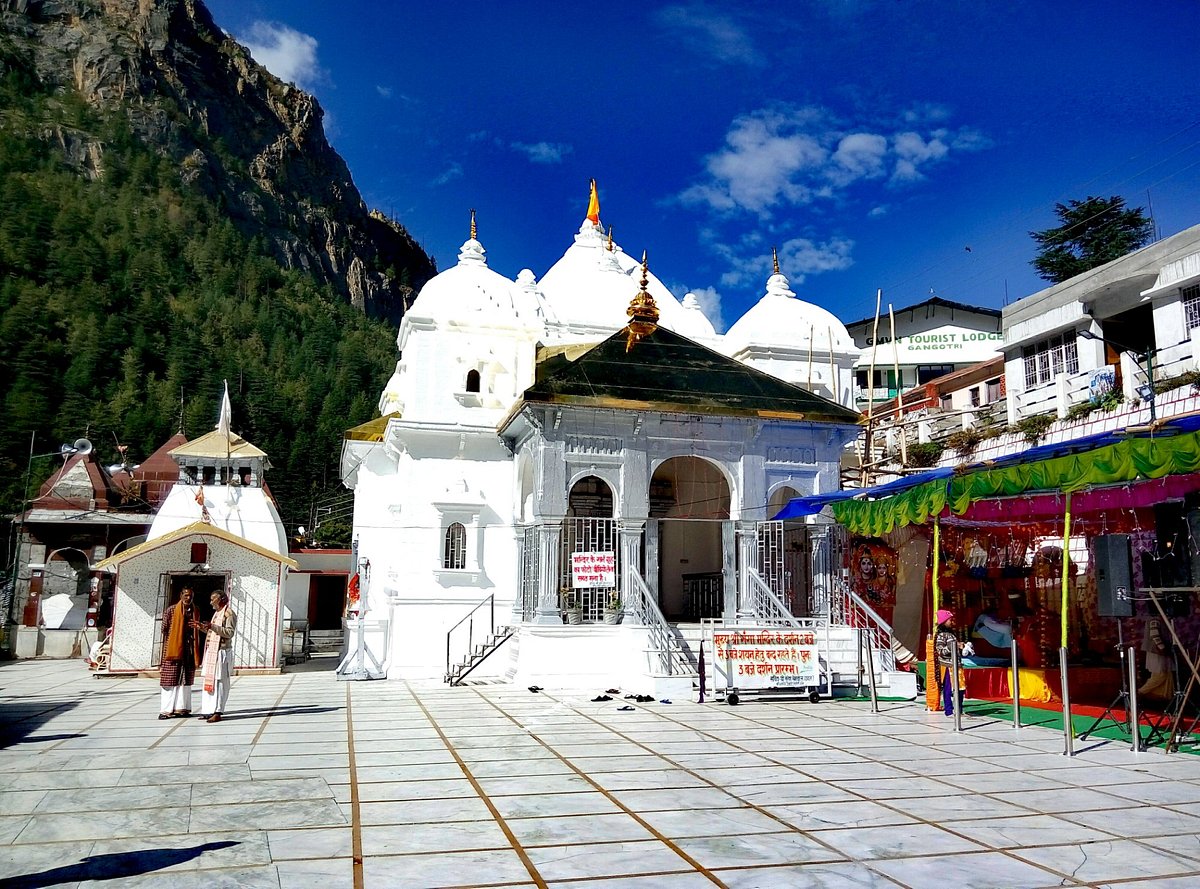
Significance of Gangotri
Hindu mythology has it that Ganga was born out of a gift given by Lord Shiva to King Bhagirath for his tireless penance. But knowing the true power of the Ganges and the calamity it would unleash if allowed to flow down unbridled, Lord Shiva caught the river in his locks, making it flow down through it. The sacred stone which took the brunt of the gushing river lies close to the Gangotri shrine, marking the place where the river first landed on earth, one of the reasons Ganga is called Bhagirathi, after her father, King Bhagirath.
During the construction of the temple by Amar Singh Thapa in the 18th century, the Gaumukh glacier, one of the sources of Ganga’s origin, was present at this very site. But over years, due to soil erosion and other environmental factors, the glacier receded to its present location

Yamunotri
Among the Chardham pilgrimages, the Yamunotri Temple was built in the 19th century close to the source of the holy Yamuna River. The temple is about a 5 kilometre hike from a remote village called Janki Chatti. There are several hot springs around the temple which are fine for taking a dip in; you will also find pilgrims cooking potatoes and rice as prasad at the temple.
You can organise your puja at a cost with the local priests at the temple. Yamunotri, the source of the Yamuna River is enclosed by forested peaks and a beautiful, sprawling valley. The second holiest river in the country after the Ganges too has a mythological connect. It is considered that a dip in the Yamuna, believed to be the daughter of Surya and sister of Yama, cleanses you of your sins.
The high-point of Yamunotri, however, remains the hot springs around it where rice is cooked and made into prasad which is distributed among devotees at the temple. In and around the Yamunotri Temple are many shrines, temples and ashrams which you can look up too and take in the holy aura of one of Chardham’s most charming sites
Significance of Yamunotri
Located at an altitude of 10,803 foot in the Garhwal Himalayas, Yamunotri is about 40 kilometre from Barkot in Uttarkashi. The actual source of Yamuna is in the Yamunotri Glacier which is at an elevation of 20,954 foot close to the Bandarpunch Peaks. Places you can explore on your Yamunotri trip include Divya Shila, Hanuman Chatti, Surya Kund and Saptarishi Kund Lake.
The Yamunotri Temple is dedicated to goddess Yamuna who is depicted by a black marble idol in the temple. Though the original Yamunotri shrine was built by Maharaja Pratap Shah of Tehri Garhwal to the left shore of the river, the present structure came up in the 19th century and was commissioned by Maharani Gularia of Jaipur in the 19th century.
Best time to visit Chardham
The Chota Chardham circuit created by Adi Shankaracharya in the 8th century comprises Gangotri, Yamunotri, Kedarnath and Badrinath. April to the first part of June is the ideal time to visit Chardham as the temperatures are bearable, making exploring in the vicinity possible and you can travel without getting cold feet and chattering teeth. You must avoid Chardham in the rainy season between June and September when the region is prone to landslides

Winter in Chardham (October through March)
The winter season is at its peak between November and February when the Garhwal Himalayas record sub-zero temperatures with excessive snowfall hampering temple visit.
It could be rather difficult to visit Chardham at this time with the weather being extremely harsh, the temples nearing their shut down period.
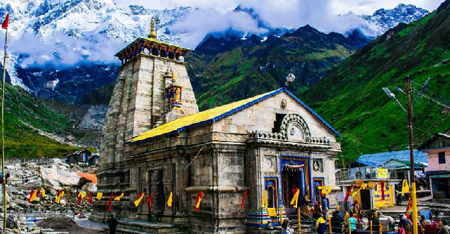
Summer in Chardham (April through June)
The Himalayan foothills are beautiful in the summer months with flowers being in full bloom, offering splendid panoramic views.
Though you would have to carry your woolens even in summer because the temperatures drop once the sun sets, while the day temperature averages between 20 and 35 degree Celsius.
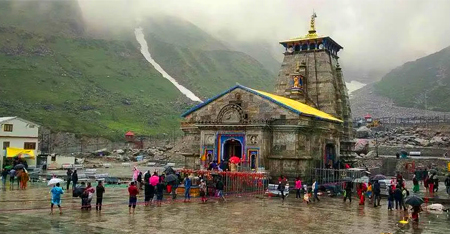
Monsoon in Chardham (June through September)
Intense showers and landslides mark the monsoon months in Chardham, with some rivers even bursting their banks. It is definitely not advisable to take up this pilgrimage in these months and wait until the beginning of October to plan your visit. The post-monsoon months has the valleys lush with flowers, the waterfalls gurgling and the surrounding vistas extremely scenic. The temperature just before a harsh winter sets in ranges between 10 and 20 degree Celsius.
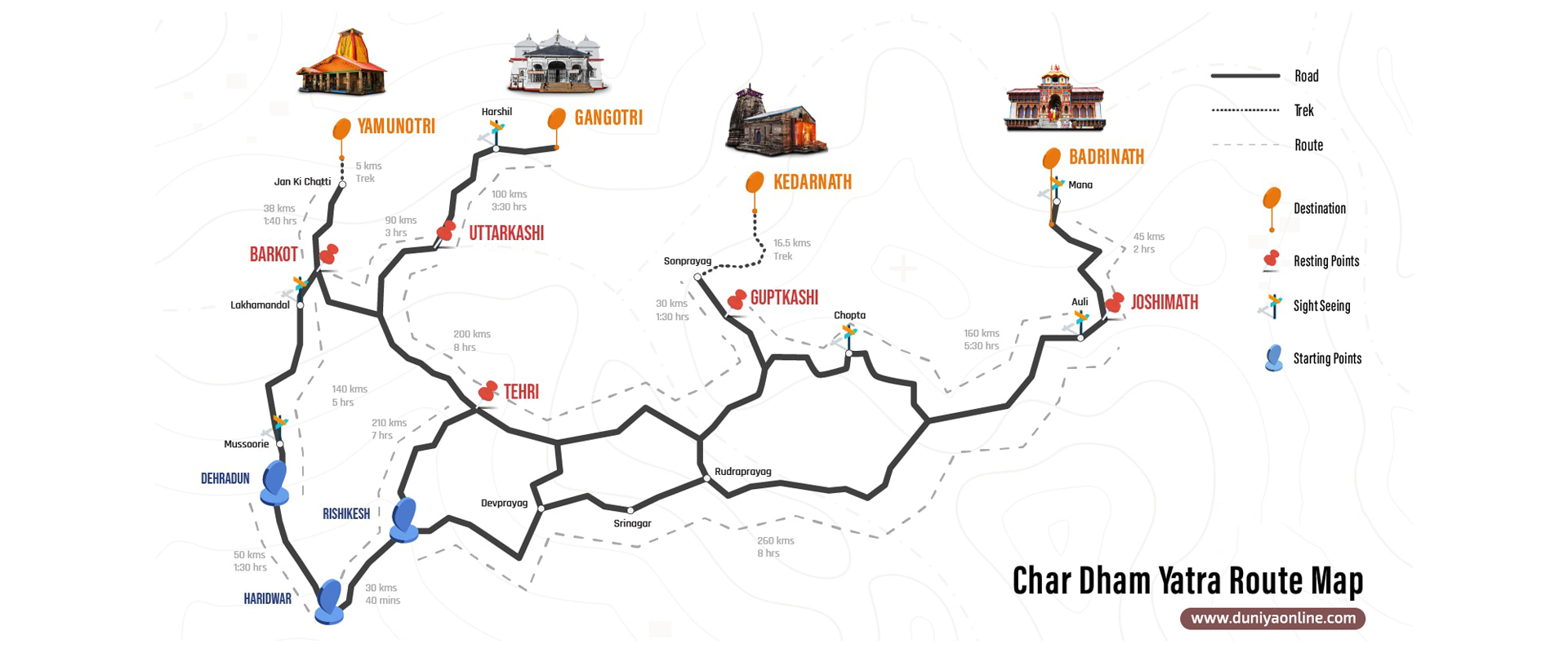
How to reach Chardham
Delhi to Haridwar: Begin your journey from Delhi and cover the 210 kilometre in about 6 hours in either bus or car. There are plenty of state and private buses plying on this route. After halting overnight in Haridwar where you can watch the Ganga Aarti in Har ki Pauri, you can begin your journey the following morning for Barkot.
Haridwar to Barkot: Begin early morning for your first Chardham shrine, the Yamunotri by travelling to Barkot which is 200 kilometre away with the journey taking nearly 10 hours. Yamunotri is about 40 kilometre further.
Barkot, a little hamlet, is at an altitude of 4002 foot. The views around Barkot are pristine and stunning, allowing you a glimpse of the Bandarpunch Peak that remains covered in snow all year round, very close to which is the source of the Yamunotri. You can halt overnight in Barkot and leave the following morning for Yamunotri
Barkot to Yamunotri and back to Barkot: Leave early morning post breakfast and continue the drive towards Yamunotri which involves a 36 kilometre drive and a 7 kilometre trek, taking you nearly 5 hours to reach Yamunotri. Instead of hiking, you can even cover the distance atop a horse. Return to stay in Barkot for the night.
Barkot to Gangotri: Begin at the crack of dawn and head towards Gangotri which takes about 9 hours from Barkot, being 210 kilometre away. En route you can stop at the hot water spring of Gangnani. To visit the authentic source of the Ganga River, you need to trek further 19 kilometre up to Gaumukh, home to the Gangotri Glacier, from the Gangotri Temple.
Gangotri to Uttarkashi: It is a spectacular feeling waking up in Gangotri. Explore around, see the stunning vistas before beginning your journey to Uttarkashi. Uttarkashi is about 95 kilometre away and you will cover the distance in about 4 hours. You can spend the night in Uttarkashi which is at an elevation of 5209 foot between the Ashi and Varuna Rivers.
These rivers merge into the Bhagirathi from both ends of the little town. Uttarkashi has river ghats just like Varanasi or Kashi after which it is named. Pay a visit to the Vishwanath Temple in Uttarkashi, among one of the important things to do in Chardham. Among other temples you can visit in this little place are Bhairav and Annapurna Temples.
Uttarkashi to Sitapur: After breakfast, head for Sitapur which is about 212 kilometre away with the journey time being about 10 hours. Sitapur at an altitude of 5971 foot above sea level is just 7 kilometre from Gaurikund and about 26 kilometre from Guptkashi. Sitapur is otherwise only 2 kilometre from Son Prayag which lies at the confluence of Mandakini and Basuki Rivers.
Another place you can visit during your stay in Sitapur include Triyuginarayan, the site of the marriage between Lord Shiva and Goddess Parvati. It is about 14 kilometre away and 5 kilometre further by foot. Close by is a hot water spring and the temple of Gauri Devi, the site where Goddess Parvati meditated for a husband like Lord Shiva
Sitapur to Gaurikund to Kedarnath: Post breakfast, head for Gaurikund which is a two-hour drive from Sitapur. You need to pack your lunch and carry enough water for the rest of the journey. After reaching Gaurikund, you shall begin your trek to Kedarnath which is about 14 kilometre away.
You will make an overnight halt in Kedarnath. The whole journey from Sitapur to Kedarnath will take roughly 9 hours. This is one of the remotest of the Chardhams nestled in a breathtaking natural setting. Towering peaks of snow, crystal streams and rivers greet you in this land of Lord Shiva’s temple shrine.
You can do the trek from Gaurikund to Kedarnath atop a horse if you cannot manage the hike
Kedarnath to Rudraprayag: Trek back the 14 kilometre distance from Kedarnath to Gaurikund where you can stop for your breakfast. From Gaurikund, leave for Rudraprayag which is 75 kilometre away. En route you can stop at Sitapur for lunch before proceeding to Rudraprayag. Rudraprayag is at the confluence of the Mandakini and Alakananda Rivers.
It is about 34 kilometre from Srinagar in Garhwal. The site is of mythological importance because it was where Narad Muni worshiped Lord Shiva and who appeared as Rudra, an avatar of Shiva, and blessed him. Rudraprayag is stunning visually and filled with interesting anecdotes dating back to the Puranas
Rudraprayag to Badrinath: After breakfast in Rudraprayag, leave for your last dham, Badrinath which is about 160 kilometre away, taking a drive time of nearly 8 hours. Make sure you leave early so that you reach the Badrinath Temple in time for evening puja and darshan.
Badrinath to Birhi: After spending the night in Badrinath, and the better part of your morning soaking up the divine aura of the place, leave for Birhi at lunchtime. The journey from Badrinath to Birhi takes nearly 5 hours, being about 95 kilometre away. You would spend the night in Birhi.
Birhi to Rishikesh: Post breakfast, proceed to Rishikesh which is about 160 kilometre away, taking roughly 7 hours. You can spend the evening in Rishikesh at the foothills of the Himalayas, by the Triveni Ghat or browse the Ram and Lakshman Jhula, take in its hippie vibe, and the infectious energy of this old town.
Rishikesh is typically an all-vegetarian city as well as alcohol free
Rishikesh to Delhi: After spending a night in Rishikesh, you can head back to Delhi by bus, or head to Haridwar and from the Haridwar Railway Station take an AC train back to Delhi.
Important points to be kept in mind before visiting Chardham
- Make an appropriate note of the opening and closing dates of the Chardham yatra announced by the Uttarakhand government every year.
- At most places you need to cover your head and of course take off your shoes. Since these are places of religious importance to Hindus, you need to show respect.
- Do not litter on your trip, and ensure you maintain the sanctity of remote locations kept at their pristine best.
- If you are visiting between October and November, carry sufficient woollen clothing as the cold would be bitter especially after sundown. But you should always wear layered clothing at any rate.
- Come equipped with sunscreen lotion, bottles of water, sunglasses and hat as the sun can be quite harsh as you go up in the hills.
- You also need to carry your own medical kit complete with antiseptic creams, painkillers, medicines for fever and common cold, antibiotics and your other routine medicine.
- Carry energy-giving snacks like granola bars and other forms of snacks.
- Some places may not allow photography. So, do not take pictures when asked not to and protect the sentiments of the locals.
- A month ahead of going on your Chardham yatra, begin some warm-up exercises so that you are equipped to handle the hikes and the steep climbs your trip might involve.
- Keep your camera and phones sufficiently charged, carry your powerbanks as some remote regions might not have regular electricity.
- Avoid picking the monsoon months for your visit to the Chardham as the slopes and roads can be quite treacherous, with landslides quite common at this time of the year.
- You need to book your hotel/guesthouse stays well ahead as the tourist season sees a huge influx of tourists, making the availability of accommodation scarce.
- On a Chardham yatra, you are not allowed to eat non-vegetarian food or even drink alcohol.
